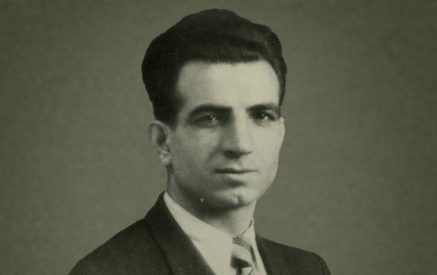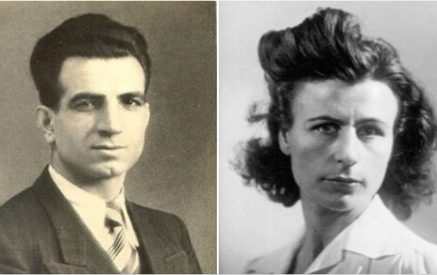by Mélanie Tuyssuzian
PARIS — Katia Guiragossian is the great-niece of Missak and Mélinée Manouchian, mythical figures of the French Resistance. Both were survivors of the Armenian Genocide and after fleeing to France, fought for France’s liberation during the Nazi occupation in 1944, as part of the legendary French Resistance. For years, she has worked to preserve their memory. She played a key role in keeping their legacy alive, resulting in the transfer of their remains to the Panthéon, where France’s most important historical figures rest, on February 21. To capture their story, Katia Guiragossian directed the documentary “Missak and Mélinée Manouchian” and wrote the preface for the book, Manouchian, written by Mélinée Manouchian.
Read also
The following is an interview conducted with her.
How do you feel today, almost three weeks after they entered the Panthéon? Are you now seeing the recognition of Missak and Mélinée actions more widely?
K: I have been working on preserving their memory for 30 years, so I have been immersed in this memory since ever. It has been a long process, but I always truly hoped that Missak and Mélinée Manouchian would enter the Panthéon, as a symbol of all their comrades and more broadly of all freedom fighters.
When was the issue of their interment in the Panthéon first considered and how was the path to its successful conclusion?
K: It was discussed starting in 2014, when four French resistance fighters were already interred in the Panthéon. We were a bit disappointed because we thought Missak Manouchian would be among them. But we finally managed it, thanks to the Élysée Palace committee that worked on the pantheonization of Missak and Mélinée. I am part of this committee and I have been working on this project for years with Jean-Pierre Sakoun, the president of the association Unité Laïque, deputy Pierre Ouzoulias, as well as the mayor of Valence Nicolas Daragon, and the historian Denis Peschanski. It was a real team effort.

Missak and Mélinée Manouchian
You wrote the preface for the book Manouchian. Why was it important for you to do that?
K: It was very important to do it because few people know the story of Missak and Mélinée Manouchian. In France, it’s something within the collective memory; we study it in school; we talk about “The Red Poster.” But still, few people know their personal stories.
Why did you choose to make the documentary “Missak and Mélinée Manouchian?”
K: I have a degree in literature, cinema, and a journalism diploma: this project suited me perfectly. I always wanted to make a documentary, but it was complicated, especially to finance it. Therefore, with the pantheonization, I told myself it was now or never, that there was a meeting I couldn’t miss. I want the Armenian diaspora to discover their story. Because it’s a tragic story, but a very beautiful story of love and commitment. They are role models, not fueled by hatred. That’s what transpires in Missak Manouchian’s last letter:“I have no hatred for the German people,” just an hour before being executed by Germans; it’s very powerful.
What will we discover in this documentary ?
K: I worked on it with Gilles Pérez and Cyrille Pérez from 13 Prod (a French production company). We are telling the story of Missak and Mélinée, through a voice-over narrative, documented by old notebooks I found in Yerevan, where Mélinée lived for 14 years after Missak’s death. We premiered it in Marseille, and it was very well received; it is now available on French channels. However, we aim to promote it internationally. I would like it to be presented in Armenia for the Golden Apricot International Film Festival. I also want to have a screening in Bourj Hammoud, Lebanon. It’s very important to me because it’s where Missak and Mélinée escaped after the Genocide. Also, I would like to have a screening in the United States. I am looking to have it translated into English.
What did you think of the Pantheon ceremony ?
K: It was extraordinary because it was dark and grandiose, just like them. The speech by the President of the Republic was perfect, in a way that I found very sincere. I found him genuinely moved. Everything was perfectly fitting, and I was truly thankful. It sends a message of hope and unity at a time when we really need it.
Do you think Mélinée is as recognized as Missak?
K: Mélinée is maybe a bit less known than Missak, but everyone knows her name because of the letter Missak dedicates to her. She embodies the essence of that letter. Initially, it was not planned for her to enter the Panthéon. I am very proud because I fought for it. At my first meeting at the Élysée, as Missak’s family by marriage, I was asked if I had a condition. I said, “Yes.” If Missak enters the Panthéon, then he must be accompanied by Mélinée; you don’t separate a legendary couple. Especially since Mélinée herself was a resistance fighter and dedicated her life to the memory of her husband Missak and all the other fighters. It’s also a tribute to all these invisible and resilient women.
To what extent does this story inspire you, potentially shaping your heritage?
K: I carried this story within me completely, especially because I spent a lot of time with my grandmother Armen, who was Mélinée’s sister. She told me a lot about Missak and Mélinée. She was a true storyteller. I interviewed her in 1997, I kept that interview and used it in my documentary. You can understand how much I was marked by this story if you see her. She is funny, touching, and radiant. We go from laughter to tears in a split second.
What are your future projects?
K: I go to Armenia a lot — two to three times a year. There, and everywhere in the diaspora, I would love to create a “Manouchian House.” That’s my goal. I would like to create the house of their dreams. With the library of their dreams. And also, have artist residencies with exchanges between poets, musicians, screenwriters, actors. Then have screenings, exhibitions. For now, it’s not real because I would need patrons to achieve it, but it’s a project that is close to my heart and that I want to fulfill in the future.
MARCH 28, 2024




























































